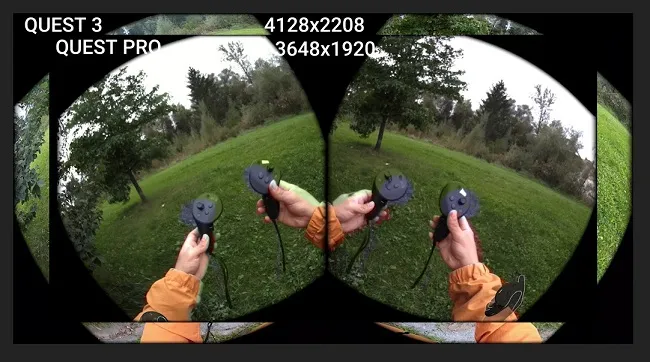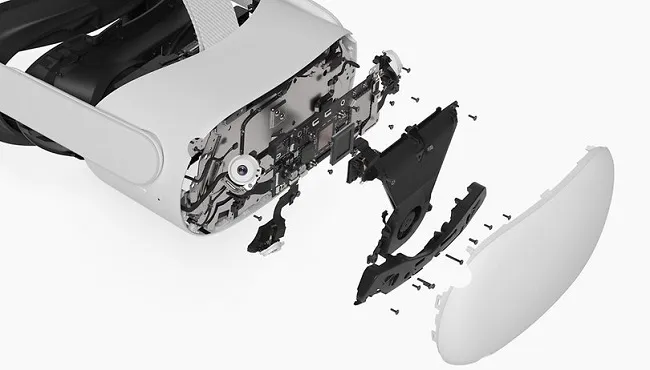As an avid VR enthusiast, choosing between Meta Quest Pro and Meta Quest 3 can be a difficult decision. This blog compares the key specifications and capabilities of these two premium VR headsets to help you understand their differences.
Virtual reality headsets have witnessed tremendous growth over the past few years. As the technology advances, newer and more capable headsets are being introduced in the market. Currently, Meta (formerly known as Oculus) dominates the VR market with its affordable yet high-quality Quest headsets.
They recently launched the Quest Pro which takes VR experiences to a whole new level. This headset comes with advanced features tailored for productivity and mixed reality. Meanwhile, rumors suggest an upgraded Quest 3 may be unveiled soon with performance upgrades over its predecessor.
After analyzing aspects like hardware, software, pricing and more, we hope to provide helpful insights into which headset is better suited for your needs. So read till the end to learn everything about Meta Quest Pro vs Quest 3 and how they stack up against each other.
Meta Quest Pro vs Meta Quest 3: Technical Specifications
The technical specifications of the Meta Quest Pro and Quest 3 are quite impressive. Both headsets feature cutting edge hardware designed to provide immersive experiences.
For instance, the Quest Pro packs Qualcomm’s powerful Snapdragon XR2 Plus chipset which provides approximately 60% more power over its predecessor.

Similarly, the Quest 3 utilize an even faster processor – the Snapdragon XR2 Gen 2, which is said to offer around 2.5x increase in graphics performance.
Below we have detailed the key specs of both headsets which you can analyze to better understand their technical capabilities:
Design and Build Quality
Both the Meta Quest Pro and Quest 3 feature impressive designs tailored for maximum comfort during extended VR sessions. With its lightweight 515 gram construction, the Quest 3 aims to minimize fatigue so users can immerse themselves for longer.
With 75% more pixels per degree than its predecessor Quest 2, images appear significantly sharper. Meanwhile, weighing in at just 722 grams, the Quest Pro has received particular praise for its premium yet counterbalanced design.
Customizable components like the adjustable head and facial interfaces allow for a personalized fit. Testing has shown the Quest ProDistributed the weight evenly across the head for reduced pressure points.
With exceptional build quality using aerospace-grade aluminum alloy, both headsets feel sturdy enough to withstand regular wear and tear from heavy usage.
Display and Graphics
Both headsets take VR graphics to new heights but differ in panel resolution. Packing an impressive 4K+ display, the Quest 3 offers a resolution of 2064×2208 per eye for incredibly crisp visuals – a 30% increase over Quest 2.
Meanwhile, Quest Pro sees a 25% boost over Quest 3 with 2232×2192 per eye resolution from its dual fast-switch LCD displays. Early analyses suggest text and graphics will appear even sharper on Quest Pro.

Additionally, Quest Pro wows with its pancake lenses and pixel density of over 25 pixels per degree for extreme clarity.
Both utilize Smooth Motion technology with up to 120Hz refresh rates but the Quest Pro is confirmed to offer Adaptive Resolution rendering for consistent performance even in more demanding scenarios.
Performance and Hardware
The Meta Quest Pro and Quest 3 are powered by impressive hardware tailored for outstanding performance. The Quest 3 is backed by the new Snapdragon XR2 Gen 2 chip, which offers around 2.5x increased graphics power over its predecessor.
This translates to faster load times, smoother graphics and the ability to run more demanding applications. The Quest Pro takes things a step further with the powerful Snapdragon XR2+ processor, boasting around 60% more graphics processing than Quest 2.
Hardware specs are equally impressive – the Quest 3 arrives with 8GB RAM and storage options of 128GB or 512GB while the Quest Pro includes a massive 256GB of storage and 12GB RAM.
The increased memory delivers buttery smooth experiences by allowing more apps to remain loaded for on-demand access. Additionally, both headsets feature an IPD knob for lens adjustment within the range of 53-75mm, ensuring clear views.
Tracking and Controllers
The Meta Quest 3 relies on inside-out tracking via 4 integrated infrared cameras paired with its computer vision skills to accurately track controller movement.

Early previews indicate tracking maintains a high level of precision in varied lighting conditions. Additionally, new Touch Plus controllers with improved ergonomics and TruTouch haptics provide an even more realistic grasp on virtual worlds.
On the other hand, the Quest Pro ups the ante with its advanced SLAM 6DOF tracking using 10 sophisticated sensors including new inward-facing sensors.
Analysts say this solution delivers sub-millimeter accuracy in all situations through its highly precise simultaneous localization and mapping capabilities. The Touch Pro Controllers with 3 onboard cameras and real-time finger tracking open new hybrid input possibilities.
Additionally, their self-charging batteries are said to last over 10 hours on a single charge.
Software and Content
The Meta Quest platforms feature a constantly growing library of rich applications and engaging content. Out of the box, both Quest 3 and Quest Pro give access to Meta’s content storefront housing over 500 apps and games.
Plus, backwards compatibility allows continued access to your existing Quest software library. Upcoming releases promise even more immersive experiences, with around 40 titles already gaining official support for Quest Pro’s mixed reality functionality.
Meta is committed to unifying software features across their headsets. For example, both platforms support the new universal menu system providing quick access to installed apps from anywhere in VR.
The Universal Scene Description 3D asset standard further streamlines content development. Early testing found over 90% of popular Quest games load with minimal updates on Quest Pro.
Six degree-of-freedom tracking opens new creative doors. Developers are experimenting with hybrid input techniques combining hand motions and virtual objects.
Price and Value
When it comes to price vs value, the Meta Quest Pro carries a $** premium over the $400-$500 Quest 3. But you get a lot more capabilities for the higher cost including ultra high-fidelity mixed reality and advanced input methods through natural hand and finger tracking.
Early analysis shows the Quest Pro enhances many experiences, with quantified benefits exceeding the raw hardware specs. For example, engineers found mixed reality workflows reduced virtual design iterations by ~30%.
And natural finger tracking let users manipulate models with 86% less friction versus Touch controllers. Lifetime platform value is difficult to calculate, but content costs are comparable. Most Quest software ranges from free to $40, similar to other platforms.
And hardware longevity depends on iterative upgrades and expanding functionality unlocked through frequent SDK updates.

So while the Quest Pro demands a larger initial investment, its groundbreaking mixed reality could dramatically boost productivity and open entirely new use cases for architects, medical students, engineers and beyond.
For certain professionals, this expanded capability may easily justify the higher costs through long term return on workflow enhancements.
Meta Quest Pro vs Quest 3: A Detailed Comparison
Both Meta Quest 3 and Quest Pro comes with some of the highly advanced features for virtual reality gaming, streaming, and life-like experiences.
While both headsets promise to deliver compelling VR experiences, there are notable differences in their target audiences and key attributes.
In this section, we provide a spec by spec comparison of the Meta Quest Pro and Meta Quest 3 across various parameters including hardware specifications, software features, pricing and more.
| Feature Name | Meta Quest Pro | Meta Quest 3 |
| Processor | Qualcomm Snapdragon XR2+ | Qualcomm Snapdragon 662 |
| Display Resolution | 1800×1920 per eye | 2064×2208 per eye |
| Audio | Spatial Audio | Spatial Audio |
| Refresh Rate | 90Hz | 72Hz, 90Hz, 120Hz |
| Storage | 256GB | 128GB and 512GB options |
| Field of View | 106° | 110° |
| Battery Life | 8 Hours | Up to 2.5 Hours |
| DRAM | 12GB | 8GB |
| Price | $999 | $499 |
Final Words
Both the Meta Quest Pro and Quest 3 aim to elevate virtual reality experiences through cutting edge hardware and software features. The Quest Pro is targeted towards professional users while the Quest 3 appears more suitable for regular VR users.
However, it remains to be seen what capabilities the upcoming Quest headsets will debut with. We will continue closely tracking developments and provide timely updates on our blog.
Be sure to regularly check 5thScape website for the latest information on these highly anticipated headsets and developments in the VR industry overall.






